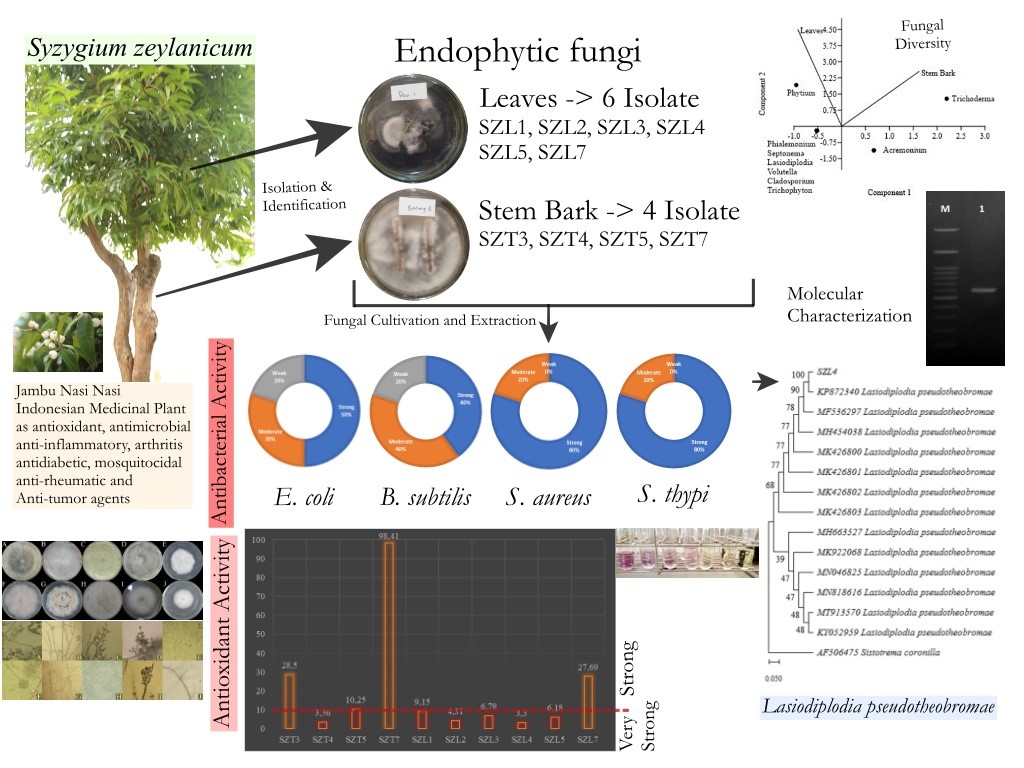Active Compound Phenyl Ether from Potential Endophytic Fungi of Syzygium zeylanicum
DOI:
https://doi.org/10.48048/tis.2023.5480Keywords:
Active compound, Antibacterial, Antioxidant, Endophytic fungi, Phenyl compoundAbstract
Endophytic fungi can be found in various types of plants, especially medicinal plants, such as Syzygium zeylanicum, one of the many medicinal plants found in Indonesia. This study aimed to obtain isolates of endophytic fungi from the bark of Syzygium zeylanicum, L., with antibacterial and antioxidant activities and identify their bioactive compounds. Characterization of endophytic fungi was carried out morphologically and fungi that showed high bioactivity were characterized molecularly. Antibacterial activity was carried out by disc diffusion method and antioxidant activity by DPPH method. Isolation of bioactive compounds was carried out by chromatographic techniques and determination of the structure of pure chemical compounds by spectroscopic analysis. In this study, 3 isolates of endophytic fungi were obtained. Based on their morphological characterization, the endophytic fungi belong to the genera Trichoderma (Code SZT2 and SZT6), and Sclerotium (Code SZT8). Trichoderma mushroom extract (SZT2) gave high antibacterial activity (74.0 % against E. coli; 78.2 % against S. aureus; 80.5 % against S. tyhpi and 74.0 % against B. subtilis). The antioxidant activity was very strong SZT2 (IC50 = 5.83 µg/mL) SZT2 potential endophytic fungus based on molecular analysis is Trichoderma koningi. SZT2 mushroom extract has an active compound in the form of compound 3-hydroxy-4(hydroxy(4-hydroxyphenyl)methyl)-ɣ-butyrolactone based on the results of compound isolation using NMR and HMR. These endophytic fungal compounds can be developed into new sources of antibacterial and antioxidant bioactive compounds through a series of further studies.
HIGHLIGHTS
- New movement in the discovery of antioxidant and antibacterial compounds with endophytic fungal sources. in this study we found compound A which have very strong antioxidant activity accompanied by strong antibacterial activity against 4 pathogenic bacteria.
GRAPHICAL ABSTRACT
Downloads
Metrics
References
DC Fontana, SD Paula, AG Torres, VHMD Souza, SF Pascholati, D Schmidt and DD Neto. Endophytic fungi: Biological control and induced resistance to phytopathogens and abiotic stresses. Pathogens 2021; 10, 570.
M Jia, L Chen, X Hai-Liang, Z Cheng-Jian, K Rahman, T Han and Q Lu-Ping. A friendly relationship between endophytic fungi and medicinal plants: A systematic review. Front. Microbiol. 2016; 7, 906.
A Knöppel, J Näsvall and DI Andersson. Evolution of antibiotic resistance without antibiotic exposure. Antimicrob. Agents Chemother. 2017; 61, e01495-17.
N Deepika, J Saranya, P Eganathan and P Sujanapal. Antimicrobial activity of Syzygium zeylanicum (L.) DC. and Syzygium hemisphericum (Walp.) alston. J. Biologically Active Prod. Nat. 2014; 4, 120-4.
L Yang, Z Xiao-Kai, L Wang, S Hong-Xia, L Xiao-Feng and W Yong-Gang. Isolation of endophytic fungi from thermopsis lanceolata and their antioxidant activity. Acta Med. Mediterranea 2018; 34, 27-31.
Y Nomi, S Shimizu, Y Sone, MT Tuyet, TP Gia, M Kamiyama and Y Otsuka. Isolation and antioxidant activity of zeylaniin a, a new macrocyclicellagitannin from Syzygium zeylanicum Leaves. J. Agr. Food Chem. 2012; 60, 10263-9
S Syarifah, E Elfita, H Widjajanti, Arum Setiawan and AR Kurniawati. Diversity of endophytic fungi from the root bark of Syzygium zeylanicum, and the antibacterial activity of fungal extracts, and secondary metabolite. Biodiversitas 2021; 22, 4572-82
D Fitriarni and RS Kasiamdari. Isolation and identification of endophytic fungi from leave and stem of calopogonium mucunoides. J. Trop. Biodiversity Biotechnol. 2018; 3, 30.
UH Habisukan, Elfita, H Widjajanti, A Setiawan and AR Kurniawati. Diversity of endophytic fungi in Syzygium aqueum. Biodiversitas 2021; 22, 1129-37.
NA Hanin and PD Fitriasari. Identification of endophytic fungi from fruits and seeds of jambolana (Syzygium cumini L.) skeels. IOP Conf. Ser. Earth Environ. Sci. 2019; 276, 012060.
T Watanabe. Pictorial atlas of soil and seed fungi. Morphologies of Cultured Fungi and Key to Species. 3rd ed. CRC Press, Florida, 2010.
TJ Walsh, RT Hayden and DH Larone. Larone’s medically important fungi: A guide to identification. ASM Press, Washington DC, 2018.
JI Pitt and AD Hocking. Fungi and food spoilage. Springer Science & Business Media, Berlin, Germany, 2009.
K Diongue, L Bréchard, MA Diallo, MC Seck, M Ndiaye, AS Badiane, S Ranque and D Ndiaye. A comparative study on phenotypic versus its-based molecular identification of dermatophytes isolated in dakar, senegal. Int. J. Microbiol. 2019; 2019, 6754058.
K Tamura, G Stecher and S Kumar. MEGA11: Molecular evolutionary genetics analysis version 11 Mol. Biol. Evol. 2021; 38, 3022-7.
JD Thompson, DG Higgins and TJ Gibson. CLUSTAL W: Improving the sensitivity of progressive multiple sequence alignment through sequence weighting, position-specific gap penalties and weight matrix choice. Nucleic Acids Res. 1994; 22, 4673-80.
B Budiono, E Elfita, M Muharni, H Yohandini and H Widjajanti. Antioxidant activity of Syzygium samarangense L. and their endophytic fungi. Molekul 2019; 14, 48.
S Goswami and S Ray. Relative total phenolics content, 1,1-diphenyl picrylhydrazyl free radical scavenging and total antioxidant potentials of seven indian medicinal plant parts’ aqueous extracts. Int. J. Pharma Bio Sci. 2017; 8, 283-91.
Y Gherbawy and K Voigt. Molecular identification of fungi. Springer, Berlin, Germany, 2010.
DS Hibbett, A Ohman, D Glotzer, M Nuhn, P Kirk and RH Nilsson. Progress in molecular and morphological taxon discovery in fungi and options for formal classification of environmental sequences. Fungal Biol. Rev. 2011; 25, 38-47.
J Ahrenfeldt, C Skaarup, H Hasman, AG Pedersen, FM Aarestrup and O Lund. Bacterial whole genome-based phylogeny: Construction of a new benchmarking dataset and assessment of some existing methods. BMC Genom. 2017; 18, 19.
D Zheng, C Huang, H Huang, Y Zhao, MRU Khan, H Zhao and L Huang. Antibacterial mechanism of curcumin: A review. Chem. Biodiversity 2020; 17, e2000171.
I Ikhtiarudin, N Agistia, N Frimayanti, T Harlianti and J Jasril. icrowave-assisted synthesis of 1-(4-hydroxyphenyl)-3-(4-methoxyphenyl)prop-2-en-1-one and its activities as an antioxidant, sunscreen, and antibacterial. Jurnal Kimia Sains Aplikasi 2019; 23, 51-60.
H Chen, G Daletos, F Okoye, D Lai, H Dai and P Proksch. A new cytotoxic cytochalasin from the endophytic fungus trichoderma harzianum. Nat. Prod. Comm. 2015; 10, 585-7.

Downloads
Published
How to Cite
Issue
Section
License
Copyright (c) 2022 Walailak University

This work is licensed under a Creative Commons Attribution-NonCommercial-NoDerivatives 4.0 International License.






